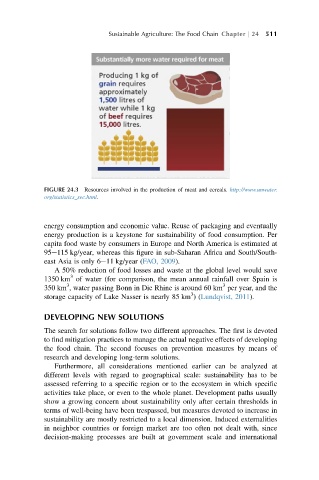Page 542 - Sustainable Cities and Communities Design Handbook
P. 542
Sustainable Agriculture: The Food Chain Chapter j 24 511
FIGURE 24.3 Resources involved in the production of meat and cereals. http://www.unwater.
org/statistics_sec.html.
energy consumption and economic value. Reuse of packaging and eventually
energy production is a keystone for sustainability of food consumption. Per
capita food waste by consumers in Europe and North America is estimated at
95e115 kg/year, whereas this figure in sub-Saharan Africa and South/South-
east Asia is only 6e11 kg/year (FAO, 2009).
A 50% reduction of food losses and waste at the global level would save
3
1350 km of water (for comparison, the mean annual rainfall over Spain is
3
3
350 km , water passing Bonn in Die Rhine is around 60 km per year, and the
3
storage capacity of Lake Nasser is nearly 85 km )(Lundqvist, 2011).
DEVELOPING NEW SOLUTIONS
The search for solutions follow two different approaches. The first is devoted
to find mitigation practices to manage the actual negative effects of developing
the food chain. The second focuses on prevention measures by means of
research and developing long-term solutions.
Furthermore, all considerations mentioned earlier can be analyzed at
different levels with regard to geographical scale: sustainability has to be
assessed referring to a specific region or to the ecosystem in which specific
activities take place, or even to the whole planet. Development paths usually
show a growing concern about sustainability only after certain thresholds in
terms of well-being have been trespassed, but measures devoted to increase in
sustainability are mostly restricted to a local dimension. Induced externalities
in neighbor countries or foreign market are too often not dealt with, since
decision-making processes are built at government scale and international

